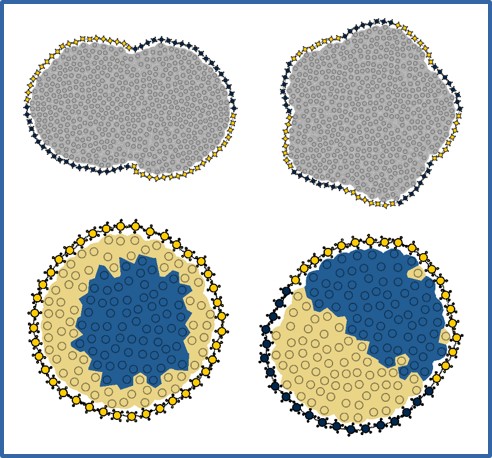Controlling Shape and Pattern in Active Colloidal Cells
Scientific Achievement
Advances in simulation and synthesis of nanoparticles and colloids are leading to a new class of active colloidal systems where self-propelled and self-rotated particles convert energy to motion. We created a simple model of “colloidal cells” from active particles such that the cells change their shape and/or form internal patterns in response to energy input.

Top row: cells with passive interiors change shape via active boundary flows.
Bottom row: cells with active interiors and active boundaries lead to core-shell and inverted Janus configurations.
Significance and Impact
Such systems hold promise for the possibility of colloidal machines — integrated systems of colloids able to carry out functions. An important step in this direction is appropriately confining colloids within cells whose shape can be controlled and within which activity can be compartmentalized. Our findings provide motivation and design rules for the fabrication of primitive colloidal machines.
Research Details
- Active colloidal cells were created by surrounding a fluid of active or passive particles with a boundary of rotationally-driven particles linked by a polymer.
- The active boundary drives convective flows inside the cell which cause it to change shape and/or direct the phase separation of active particles within the cell.
Shape Control and Compartmentalization in Active Colloidal Cells
Spellings, M., Engel, M., Klotsa, D., Sabrina, S., Drews, A.M., Nguyen, H.P., Bishop, K.J.M., Glotzer, S.C.
Proc. Natl. Acad. Sci. U. S. A. 112, 2015, 34.
Work performed at University of Michigan-Ann Arbor and The Pennsylvania State University.
